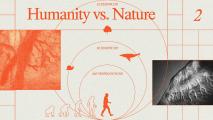Scientists have discovered new “giant viruses” in Massachusetts’ Harvard Forest — and many of them are unlike anything we’ve seen before.
The challenge: Viruses are microbes that can only replicate inside the cells of a separate living host — depending on the virus, this can mean people, animals, plants, or even other microorganisms, like bacteria.
Giant viruses are physically larger-than-normal and often have remarkably large genomes, too.
While many of the viruses that cause sickness in humans are well studied, researchers estimate that there are millions more that we don’t know anything about — identifying and analyzing those mystery viruses can help us understand the role they play in our health and environment, for better or worse.
What’s new? In 2018, US researchers used genomic sequencing to analyze soil in the Harvard Forest (actually about 70 miles from Harvard University). The results made them suspect the forest contained many previously unknown species of giant viruses.
As the name suggests, these are physically larger-than-normal viruses — while a typical virus is about 100 nanometers wide, giant viruses range from 200 to 750 nm — and they often have remarkably large genomes, too.
One of the researchers involved in that study — Jeffrey Blanchard from the University of Massachusetts — then teamed up with scientists at the Max Planck Institute for Medical Research in Germany to take a closer look at Harvard Forest soil.
Many of the giant viruses have never-before-scene characteristics, including tubular appendages, unusual tails, and strange, hair-like coatings.
This time, they used electron microscopy — a technique that uses beams of electrons to illuminate and magnify objects — to actually see the viruses suggested by the genetic sequencing study.
They’ve shared images of some of these giant viruses in a new paper, available on the preprint server bioRXiv, as well as details about how many of them have never-before-scene characteristics, including tubular appendages, unusual tails, and strange, hair-like coatings.
Looking ahead: While the researchers are highly confident that they’ve imaged giant viruses, they refer to them as “virus-like particles” in the paper — that’s because something looking like a virus isn’t enough to confirm that that’s what it is.
Their findings also need to undergo peer review, too, but if they hold up, they’ll add to our growing understanding of the viruses — big and small — hidden all around us.
We’d love to hear from you! If you have a comment about this article or if you have a tip for a future Freethink story, please email us at [email protected].





